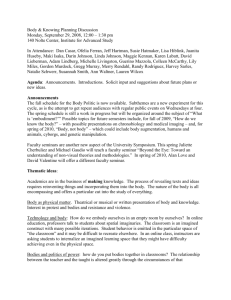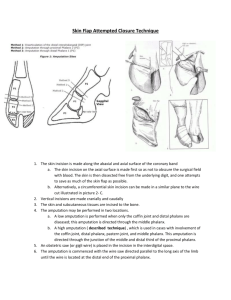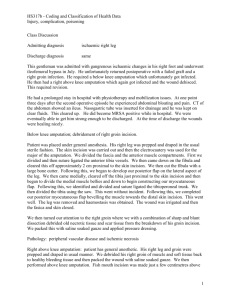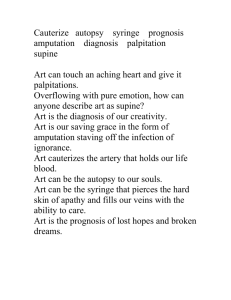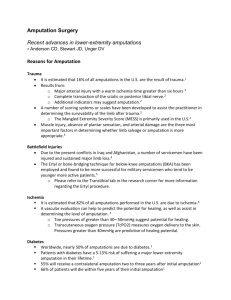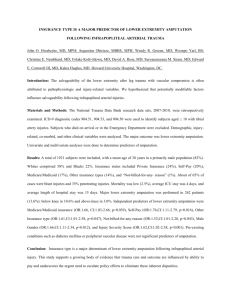Document 13792747
advertisement
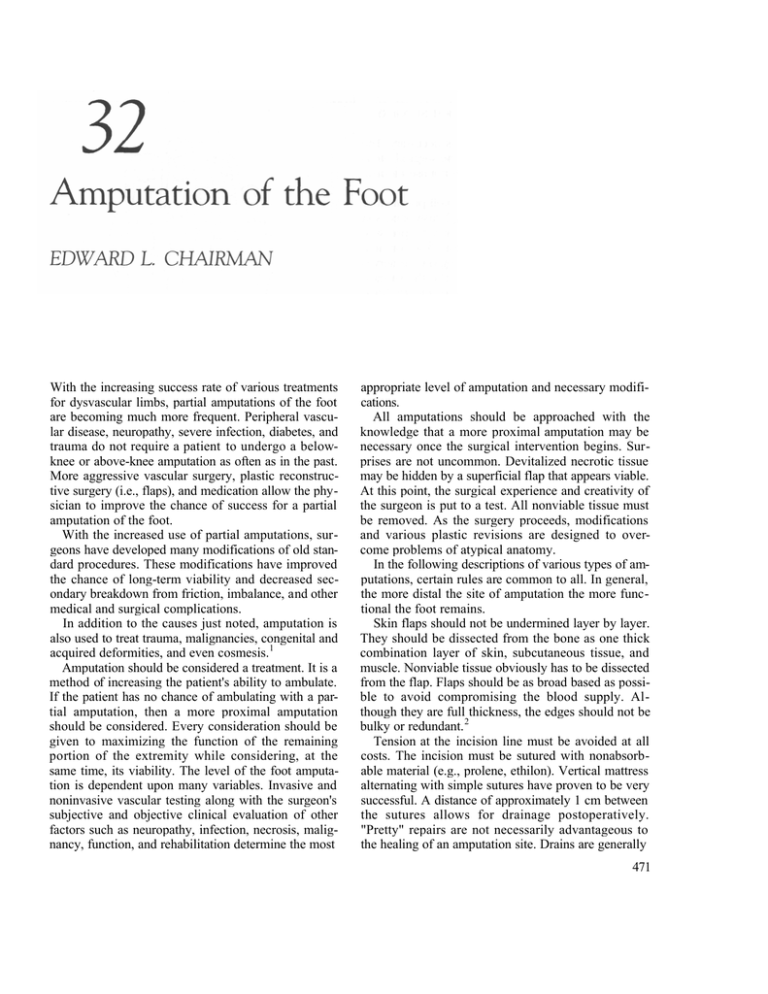
With the increasing success rate of various treatments for dysvascular limbs, partial amputations of the foot are becoming much more frequent. Peripheral vascular disease, neuropathy, severe infection, diabetes, and trauma do not require a patient to undergo a belowknee or above-knee amputation as often as in the past. More aggressive vascular surgery, plastic reconstructive surgery (i.e., flaps), and medication allow the physician to improve the chance of success for a partial amputation of the foot. With the increased use of partial amputations, surgeons have developed many modifications of old standard procedures. These modifications have improved the chance of long-term viability and decreased secondary breakdown from friction, imbalance, and other medical and surgical complications. In addition to the causes just noted, amputation is also used to treat trauma, malignancies, congenital and acquired deformities, and even cosmesis.1 Amputation should be considered a treatment. It is a method of increasing the patient's ability to ambulate. If the patient has no chance of ambulating with a partial amputation, then a more proximal amputation should be considered. Every consideration should be given to maximizing the function of the remaining portion of the extremity while considering, at the same time, its viability. The level of the foot amputation is dependent upon many variables. Invasive and noninvasive vascular testing along with the surgeon's subjective and objective clinical evaluation of other factors such as neuropathy, infection, necrosis, malignancy, function, and rehabilitation determine the most appropriate level of amputation and necessary modifications. All amputations should be approached with the knowledge that a more proximal amputation may be necessary once the surgical intervention begins. Surprises are not uncommon. Devitalized necrotic tissue may be hidden by a superficial flap that appears viable. At this point, the surgical experience and creativity of the surgeon is put to a test. All nonviable tissue must be removed. As the surgery proceeds, modifications and various plastic revisions are designed to overcome problems of atypical anatomy. In the following descriptions of various types of amputations, certain rules are common to all. In general, the more distal the site of amputation the more functional the foot remains. Skin flaps should not be undermined layer by layer. They should be dissected from the bone as one thick combination layer of skin, subcutaneous tissue, and muscle. Nonviable tissue obviously has to be dissected from the flap. Flaps should be as broad based as possible to avoid compromising the blood supply. Although they are full thickness, the edges should not be bulky or redundant. 2 Tension at the incision line must be avoided at all costs. The incision must be sutured with nonabsorbable material (e.g., prolene, ethilon). Vertical mattress alternating with simple sutures have proven to be very successful. A distance of approximately 1 cm between the sutures allows for drainage postoperatively. "Pretty" repairs are not necessarily advantageous to the healing of an amputation site. Drains are generally 471 472 HALLUX VALGUS AND FOREFOOT SURGERY used when the surgeon believes it is necessary. The amount of drainage and seepage in the surgical site is easily determined if the surgeon does not use a tourniquet for the procedure. All nerves should be cut at a site well proximal to the incision and preferably in a well-cushioned soft tissue mass. This helps avoid irritation by pressure from the prosthesis or other shoe gear. Traction neuropathy can be avoided by not pulling on the nerves when dissecting. 2 All bone edges left in the surgical site should be rounded off and rasped smooth. Bone wax should be avoided on bone edges to avoid any chance of a foreign body reaction. 2 Dressings of an amputation site should provide mild to moderate compression but no proximal constriction. Ice and elevation are used postoperatively only if the leg is not ischemic. Early weight-bearing will negate the best surgical technique. However, range-of-motion exercises and muscle strengthening can be started at an early stage. It should be noted that not all amputations can be finished with primary closure. At times, the wound must be packed open and a second or third surgery will be necessary to debride infected and nonviable tissue before closure. When this is the case, the original flaps should be approximately 20 percent longer than would be used to cover the stump in primary closure; this allows for shrinkage of the flaps.3 SYME TERMINAL AMPUTATION The Syme terminal amputation has been used by many surgeons to overcome an onychauxic or mycotic and ingrown nail. The procedure includes the radical excision of the matrix, nail, and nailbed along with the distal half of the distal phalanx (Fig. 32-1). Technique The plantar incision is distal to the more proximal dorsal skin flap, which is made at the level of the intended bone resection. Using a power saw, a transverse osteotomy is performed at the junction of the proximal and middle one-third of the phalanx. The osteotomy is performed so that the plantar surface is more proximal than the dorsal surface. All edges are contoured and rasped smooth. The area is flushed copiously with sterile saline and antibiotic irrigant. The plantar flap is then brought dorsally and trimmed to the proper length allowing closure without tension. Vertical mattress or simple sutures are used to approximate the incision line. Betadine-soaked sterile dressings followed by dry sterile fluff and mild compression are used to dress the wound.4 Although this procedure is still in vogue, many plastic procedures can be used to overcome the onychauxic nail with the hypertrophied tuft. Amputation of the distal portion of the toe is not necessarily the best approach to overcome a cosmetic problem but works well to eliminate an ulcerated or nonviable area where the proximal tissue is still viable. AMPUTATION OF THE FOOT 473 LESSER TOE AMPUTATION When lesser toes are individually amputated, several techniques may be applied. The significant fact to remember is that any closure of the amputated stump should be tension free. Whether one uses a plantar flap, a dorsal flap, variations of side flaps, or elliptical incisions, lack of tension is the most significant technical requirement for success in an amputation where all other preoperative criteria were fulfilled. The technical approach to the amputation varies with the incision line. The optimal site for a digital amputation is at the level of the metatarsophalangeal joint. The choice of incision depends on the anatomy of the forefoot. Whether the incision is elliptical or flap, the surgical approach after the incision is basically the same. My preference is to perform this amputation with a tear-shaped incision in the web around the toe (Fig. 32-2). The apex of the incision is dorsal. The dorsal part of the incision is carried proximally over the metatarsophalangeal joint. With sharp and blunt dissection, the surrounding skin and subcutaneous tissue are reflected aside. All bleeders are cauterized. The extensor and flexor tendons are pulled distally and severed at their most proximal portion in the wound. The capsule is then incised, allowing the surgeon to remove the toe in toto. If dead space is a concern, the base of the proximal phalanx may be left intact. If there is redundant subcutaneous tissue, it is dissected out of the wound. However, in most cases this is not the fact. Nonviable tissue is removed. If it is determined that the nonviable tissue continues proximally, a more radical amputation (i.e., ray amputation or possibly transmetatarsal amputation) should be considered at this time. If all nonviable tissue is adequately removed from the wound, the subcutaneous tissue can be approximated over the metatarsal head with absorbable sutures. This acts as a cushion. It is my preference to leave the cartilage on the metatarsal head intact; I only remove the cartilage when it shows signs of nonviability. The skin is approximated with a nonabsorbable suture (i.e., prolene or ethilon). Vertical mattress sutures interspersed with simple interrupted sutures allow for an adequate closure without tension. The wound is then dressed with betadine-soaked sterile dressings followed by dry sterile fluff and mild compression. No Ace bandage is used. Depending on the viability and circulation of the remaining limb, surgeons should use their judgment in recommending ice or elevation. I do not find it necessary to use a drain in digital amputations. However, if in one's judgment a drain is needed, it should be inserted at the most plantar aspect of the incision, allowing for gravity drainage. There should be no rush to remove the sutures postoperatively. Most patients who require amputations of any sort usually require more time for healing. It is not uncommon to allow sutures to remain for more than 30 days if the surgeon judges this to be necessary. Prostheses for amputated toes are as varied as surgical approaches to amputation. Whatever material is 474 HALLUX VALGUS AND FOREFOOT SURGERY used, a prosthesis is to act as a spacer between the remaining toes. If a second toe is being amputated and a hallux valgus already exists, it is not necessary to provide any spacer. However, if no hallux valgus exists, it is very likely that one will develop if the second toe is amputated.5 A spacer slows down the progression of the hallux valgus but does not stop it. In addition to the consideration of a spacer, the surgeon should prescribe a metatarsal bar behind the metatarsal heads to allowing for toe-off without increased stress on the affected metatarsal head. Amputation of two or more lesser toes modifies the initial incision and approach somewhat. The toes can be removed individually as previously noted, or a combined incision around the affected toes can be considered. Curvilinear incisions made on the dorsal and plantar aspect of the affected toes meet at the medial and lateral aspects (Fig. 32-3). The affected toes are then removed in similar fashion to that used for individual toes. The plantar flap is pulled dorsally to meet the dorsal incision. Vertical mattress and simple interrupted sutures are used to approximate the wound. AMPUTATION OF THE HALLUX The anatomy of the hallux requires us to approach its amputation differently than we would that of a lesser toe. Because the base of the proximal phalanx is used for the insertion of various tendons, an attempt is made to save it. If the plantar flap is viable, a more distal transverse curvilinear incision is made at the level of the midproximal phalanx. A corresponding dorsal curvilinear incision is made over the base of the proximal phalanx. Both incisions meet on the medial and lateral aspect of the toe. It has been my practice to place my initial incisions as distal as possible allowing modification of flaps at closure. After the incision is made, sharp and blunt dissection separates the subcutaneous tissue from the bone. The dorsal and plantar flaps are retracted proximally allowing the surgeon to expose the dorsum of the base of the proximal phalanx. The extensor hallucis longus and flexor hallucis longus tendons are severed, and depending on the viability of the limb and the patient may be sutured into the capsule of the metatar- sal phalangeal joint. A transverse osteotomy is performed at the junction of the proximal and middle thirds of the proximal phalanx. The osteotomy should be slightly more proximal on its plantar aspect. The remaining edges of the proximal phalanx are rasped smooth with a bone rasp followed by copious flushing with sterile saline and an antibiotic solution. With the hallux removed the plantar flap should be approximated dorsally over the base of the proximal phalanx. Keep in mind that the plantar circulation is usually better than the dorsal circulation. All excess skin and subcutaneous tissue can be removed when remodeling the flap. Ideally, the base of the proximal phalanx should be saved,6 but this is not always practicable. Variations of hallux amputation include the removal of the proximal and distal phalanx allowing the metatarsal head to AMPUTATION OF THE FOOT 475 remain. Attempts should be made to suture the flexor hallucis brevis tendon into the distal portion of the capsule of the metatarsal phalangeal joint. This will allow the patient to maintain the sesamoids in a proper position. Additional attempts should be made to suture the flexor and extensor hallucis longus tendons together, allowing good function at this level. Plantar flaps are ideal for this type of amputation. However, medial plantar flaps may be more practical, depending on the remaining tissue viability. In practice, I find it necessary to remove the first metatarsal head when it is necessary to do a full hallux amputation. My experience indicates that this prevents breakdown at the medioplantar and plantar aspects of the first metatarsal head postoperatively. The surgical technique for this procedure is modified to allow for a plantar medial flap to close the wound. The skin should not be underscored superficially. Full thickness separation of bone from subcutaneous tissue is done with adequate blunt and sharp dissection. The osteotomy is performed approximately at the level of the junction of the middle and distal one- thirds of the first metatarsal. The osteotomy is performed from dorsal to plantar in an oblique fashion allowing the dorsolateral aspect to be distal while the medial plantar aspect is proximal. The plantar edge of the remaining shaft of the metatarsal should be rasped smooth. No spurs or rough edges should be allowed. The area is copiously flushed with saline and antibiotic irrigant. The plantar medial flap is approximated over the remaining metatarsal and remodeled to close without tension. When suturing the flap, care should be taken to ensure that the lateral sutures do not ligate any of the vasculature leading to the second toe. The sutures should be placed approximately 1 cm. apart allowing for drainage postoperatively. If a drain is warranted, it should be placed at the most proximal plantar portion of the wound allowing for gravity drainage. A betadine-soaked sterile dressing followed by dry sterile fluff and gauze is applied to the wound with mild compression. The surgeon's judgment is needed to determine whether application of an Ace bandage is appropriate or whether ice and elevation are required postoperatively (Fig. 32-4). 476 HALLUX VALGUS AND FOREFOOT SURGERY METATARSAL RAY RESECTION Metatarsal ray resection is used in cosmesis (removing a supernumerary ray) and in excision of devitalized tissue. The procedure is an excellent method in removing the cause of chronic ulcerations (Fig. 32-5). Technique and postoperative care must be altered for various ray resections. Again, tension in the flap must be avoided. Removal of one or more of the metatarsals causes a shift in the weight-bearing of the remaining metatarsals. Compensation must be considered in postoperative orthosis and gait training. Technique It is advantageous to do this procedure without a tourniquet. However, this is left to the judgment of the surgeon. The incision varies from a racket type around the base of the toe, with an elongated handle dorsally allowing exposure of much of the metatarsal shaft, to elliptical incisions around the base of the toe and ulceration with a dorsal extension. Again, the surgeon's judgment is necessary in planning the actual incision that will allow for good exposure, avoidance of dead space, and no tension on the incision line. Once the incision is made, sharp and blunt dissection is used to separate the metatarsal from the surrounding tissue. Using a power saw, the proximal portion of the metatarsal shaft should be transected in an oblique manner allowing the plantar surface of the remaining stump to be more proximal than the dorsal surface. The edges of the remaining stump should be rasped smooth. The area should be flushed copiously with sterile saline and antibiotic irrigant. All devitalized tissue should be AMPUTATION OF THE FOOT 477 removed. Extensor and flexor tendons inserting into the affected ray should be dissected proximally and if possible reinserted into a more proximal position at the base of the affected metatarsal. Drains should be used when excessive bleeding or oozing is noted or infection is present. In fact, the surgeon may decide to leave the incision open and pack it if infection is present. When the first or fifth rays are to be amputated, the incision should be made in such a way as to allow as much of the plantar medial or plantar lateral flap to be brought up and approximated dorsally. When the first and second rays are removed, postoperative ambulation causes increased weight-bearing on the lesser metatarsals and a medial shifting of the lesser digits. This shift in weight-bearing and position then cause additional ulcerations that ultimately lead to further amputation. Although I personally have been successful in first and second metatarsal amputations, it is my opinion in general that a transmetatarsal amputation will be more successful. Patients may find amputation of the first and second ray easier to accept but with proper instruction can realize they have a better chance statistically by choosing a transmetatarsal amputation. TRANSMETATARSAL AMPUTATION In my experience, transmetatarsal amputations are very successful (Figs. 32-6 and 32-7). Certain criteria are required for this statement to be valid. It is obvious that circulatory viability is a must. If gangrene is present, it must be well demarcated distal to the amputation site. The plantar flap must be viable for successful closure. Infection, if present, must be under control. Transmetatarsal amputations may necessarily be performed in two phases. However, the following technique is described as if one surgery is being done. Technique Although some surgeons make their initial dorsal incision at the level of the amputation site desired, it is my preference to make both the plantar and dorsal incisions as distal as possible allowing remodeling of the flap at closure. It is not uncommon to require a twostep surgical approach to transmetatarsal and more proximal amputations. Thus, as stated previously, the dorsal and plantar flaps should be approximately 20 percent longer than will be necessary to close over the stump in a second surgery. This allows for the normal shrinkage of the flaps between the primary and secondary operations.3 The actual level of the transmetatarsal amputation varies from just proximal to the metatarsal head to just distal of the bases of the metatarsals. The choice of the level of transmetatarsal amputation depends on the amount of viable tissue needed to allow soft tissue closure without tension plus the viability and function of the remaining stump. The plantar and dorsal incisions are transverse curvilinear. They meet more proximally at a sharp point on the medial and lateral sides of the foot. Dissection is carried down to bone without dissecting planes. The skin, subcutaneous tissue, muscle, and other tissues are dissected in toto and separated from the bone. The transverse osteotomy of the metatarsals is done in a parabolic fashion allowing for medial and lateral beveling on the first and fifth metatarsals, respectively. The osteotomy of all five bones should be done in such a fashion that the cut should be from dorsal distal to plantar proximal. This will ultimately allow ambula- 478 HALLUX VALGUS AND FOREFOOT SURGERY tion without causing irritation or friction on the plantar-distal aspect of the foot. Care should be taken to dissect and sever all nerves proximal to the actual osteotomy site. Tendons should be pulled distally and severed proximally, allowing them to then retract out of the amputation site. When the surgeon is confident that all the nonviable tissue has been dissected out, it is time to revise the plantar and dorsal flap in such a manner that the ultimate repair is on the dorsum of the metatarsals. Dog ears in the corners are avoided by bringing the original plantar and dorsal incisions to a sharp corner on the medial and lateral aspect. Care is taken to close the incision with no tension. Number 2-0 vertical mattress sutures are used to approximate the skin and subcutaneous tissue. All sutures should be at least 1 cm. apart. Drains are used if the surgeon judges they are necessary for removal of exudate and blood. I have found that repair of the incision with sutures 1 cm. apart often eliminates the need for a drain. The gapping of the incision allows drainage along the total incision line. Betadine-soaked sterile dressings followed by dry sterile fluff and mild compression work well to minimize edema and dehiscence. Sutures are left in for at least 3 to 4 weeks and sometimes longer. Early ambulation is absolutely contraindicated. I have found that any weight-bearing stresses the incision line and should be avoided for at least 1 month. Range-of-motion exercise at the ankle level can be started immediately after surgery but no weight-bearing is permitted. Earlier ambulation can be successful if a short leg walking cast is used. However, my preference is to keep a full range of motion at the ankle level and eliminate all weight-bearing for 4 weeks. AMPUTATION OF THE FOOT 479 LISFRANC AMPUTATION The Lisfranc amputation is defined as a tarsal metatarsal disarticulation (Fig. 32-8). We should not lose sight of the fact that amputations are varied to suit the remaining viability of the extremity. All the contributing factors that have been discussed in previous amputations are relevant here. Although a Lisfranc amputation is a disarticulation at the tarsal metatarsal joint, it should be noted that this amputation must be modified to increase its chance of success. Initial incisions through the dorsal and plantar surface are similar to those described for the transmetatarsal amputation. The incisions are made as distal as the viability of the tissue will allow. The plantar and dorsal incisions are transverse curvilinear, meeting at the medial and lateral borders of the foot in a sharp point. Planes are not dissected. All tissue surrounding the bone is separated from the bone and flapped proximally. The tarsal metatarsal joints are incised dorsally and plantarly and disarticulated. The distal surface of the medial cuneiform protrudes distally in front of the other distal tarsal bones. With this in mind, an attempt should be made to remodel the medial cuneiform in such a way that the medial and plantar aspects are beveled proximally and the anterior aspect should be even with the middle cuneiform. The plantar edge of the middle and lateral cuneiforms as well as the lateral and plantar edges of the cuboid should be beveled in such a manner as to avoid friction on ambulation. All nerves should be severed proximal to the incision. Tendons should be pulled distally and severed at their most proximal exposure and then allowed to retract out of the amputation site. Ulcers and nonviable tissue should be removed from the surgical site. The dorsal and plantar flap can then be revised in the best possible manner allowing for the final repair to be performed dorsally. As before, dog ears are avoided by bringing the dorsal and plantar incisions together on the medial and lateral aspect in a sharp corner. No tension should be allowed at the incision site. Number 2-0 nonabsorbable (ethilon, prolene) vertical mattress sutures should be used to approximate the skin and subcutaneous tissue. All sutures should be placed approximately 1 cm. apart. As before, I use drains only when I judge that it is necessary for the removal of exudate and blood. The 1 cm. gapping between sutures allows for most drainage to be eliminated throughout the incision line. The wound is dressed with betadine-soaked sterile dressings followed by dry sterile fluff and mild compression. Early ambulation is prohibited. The sutures remain intact for at least 4 weeks. Ambulation is allowed only after the sutures are removed and the incision line is intact. Exercises are permitted for range of motion at the ankle level while the extremity is elevated. Postoperatively, complications have occurred with this type of disarticulation. Equinovarus is a common post-operative problem leading to ulcers and tyloma on the distal aspect of the foot and the incision line.7 This has been overcome quite adequately with the reinsertion of the extensor tendons and the peroneal tendons at a more proximal site. Some surgeons perform an achilles tendon lengthening when they think that an equinovarus is probable.1 CHOPART AMPUTATION The Chopart amputation (Fig. 32-9) is a disarticulation through the talonavicular and calcaneocuboid joints. The procedure is not commonly performed because of postoperative problems. 480 HALLUX VALGUS AND FOREFOOT SURGERY PIROGOFF, BOYD, AND SYME AMPUTATIONS More proximal partial foot amputations include the Pirogoff amputation and Boyd amputation. Both amputations are attempts to keep the full length of the extremity and allow weight-bearing using a portion of the calcaneus as an end-bearing stump. The Syme amputation is an actual disarticulation at the ankle joint but a retention of the heel flap for cushioning of the stump. These more proximal amputations are rarely used. Historically, they present many postoperative complications and difficulty with ambulation. They are mentioned here only as a reference to additional possibilities. The technique is essentially the same as that of a Lisfranc amputation. The dorsal and plantar incision meet more proximally on the medial and lateral border. Dissection of the subcutaneous tissue and muscle down to bone is carried out in a manner similar to the Lisfranc and transmetatarsal procedures. The disarticulation is done at the midtarsal joint. The distal-dorsal and distal-plantar surfaces of the talus and calcaneus, respectively, are beveled in such a manner as to reduce friction on the anterior aspect of the stump. The extensor tendons and tibialis anterior must be reimplanted in the dorsum of the talar head. Closure of the wound is carried out in the manner already described for the Lisfranc amputation. The dressing is applied with betadine-soaked sterile dressings followed by dry sterile fluff and compression. However, a posterior rigid splint should be used to prevent an equinus deformity. In addition to nonweight-bearing for at least 1 month, the posterior splint must be worn for the same time. REFERENCES 1. Wagner WF: Amputations of the foot and ankle, p. 93. In Moore WS (ed). Lower Extremity Amputation. 1st Ed. WB Saunders, Philadelphia, 1989 2. Berardi RS, Keomny: Amputations in peripheral vascular occlusive disease. Am J Surg 135:231, 1978 3. Roach JJ, Deutsch A, McFarlane DS: Resurrection of the amputations of Lisfranc and Choparts for diabetic gangrene. Arch Surg 122:931, 1987 4. Sanders LJ: Amputations in the diabetic foot. Clin Podiatr Med Surg 4:481, 1987 5. Turek SL: Amputations, p. 1487. In Orthopaedics. 3rd Ed. JB Lippincott, Philadelphia, 1977 6. Bohne WH: Toe amputation, p. 37. In Atlas of Amputation Surgery. 1st Ed. Thieme Medical, New York, 1987 7. Greene WB, Cary JM: Partial foot amputations in children. J Bone Joint Surg [AM] 64:438, 1982

